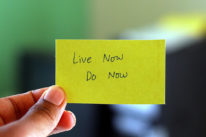
“Life is a balance between what we can control and what we cannot. I am learning to live between effort and surrender.” ~Danielle Orner
For too long, I felt myself pulled between two shores of my identity. On one side was my yoga teacher, meditator, healer identity—my tender side. On the other side was my activist, change-maker role—my fierce side.
I always felt like I was too tender for some and too fierce for others. It made me feel like I didn’t fit in anywhere.
Definitely the soft-hearted “woo” person in my activist circles. And I was definitely the one talking about structural oppression and other activist ideas in my yoga teacher trainings. (The ahimsa lecture was always a sticky one.)
What I now know is that both of these sides of myself are valid. Both are necessary for living in the world, whether you want to bring healing, love, and light—or whether you want to really shake things up.
The problem is not that both of these exist (both do, in all of us). The problem is what happens when they are out of balance.
When we favor our tender side too much, we might succumb to heartbreak and collapse. If we let our fierce side get too strong, our anger might consume us until we flame out. Either option is a recipe for burnout and exhaustion.
This is your official permission slip to embrace both of these sides of yourself.
When I became a mom, my perspective shifted dramatically. While I aimed to be a tender, safe container for my baby, I also had to be a warrior-advocate for him on a number of fronts.
New motherhood was also a time when I had to admit vulnerabilities in myself like I never had before, while having less access to outlets for my fierce activism. I had to admit that I had no idea what I was doing; that I needed help; and that I needed to take a step back from certain areas of life.
It was tender. And it was an act of fierce self-love. I learned that we needed both, not just within us, but at the same time.
My self-care also shifted. I couldn’t procrastinate or be wishy-washy anymore. I had to clearly (sometimes fiercely communicate) my needs.
I also had to slow way down and shift my expectations for myself. I had to invite a sense of tenderness into my days, even when it would have been much easier to push harder. I incorporate a sense of flow into my days, even when it feels challenging to allow myself that.
That looks like taking dedicated, structured time for myself and my work when my energy is high. And it looks like easing off a little bit when my energy is lower. This requires clear communication with those around me, and a lot of grace for myself.
It takes both the fierce side and the tender side, working together.
Now, I’ll be honest: Society is sometimes not wild about folks being fierce and tender. It can be very gendered: men are expected to be tough and fierce; women are expected to be sweet and tender. So we’re breaking the rules.
But trust me when I say that it’s worth it. It’s worth it to embrace your whole self. Ultimately, those around you (and the world!) will benefit from you showing up as your complete self.
Yes, our fiery side will make some folks uncomfortable, just the way our vulnerabilities will. Everyone will survive that discomfort. Just remember that your tender heartbreak is valid—as is your fierce desire to create transformation.
Sometimes it feels as though nuance is no longer welcome—that we’re reduced to what we can fit into an Instagram caption. But you are allowed to be complicated.
There’s a myth that being fierce isn’t spiritual—that we’re all supposed to be perfectly calm all the time. That just isn’t true. Our fierce side—or any other reaction to oppression or the state of the world—is just a set of conditions we’re working with.
Anger is simply another part of our experience. In fact, it offers us grist for our practice. Beyond our own individual practice, our fierce side is a lamp to illuminate injustice and show the path forward.
On the other hand, there’s a misconception that if we’re “too” tender, then we’ll crumple when the going gets tough. It’s true that we don’t want to become victim to our emotions. It is a gift to be able to work with them skillfully.
Our tenderness, though, is actually an asset. Tenderness allows us to perceive our interconnection more easily—to recognize ourselves in others, and vice versa. It is the foundation of a more compassionate world.
This is why I (and we) need both. When there’s too much of one, we fall out of balance. There are gifts to embracing both, of being somewhere in the middle.
To create more of this balance, it’s important to know your tendencies. Do you tend toward the fierce side or the tender side? With that information, you can navigate ways to create more equilibrium and communication between those two sides.
If you tend more toward the fierce side, practice getting in touch with the feelings underneath any anger or reactivity. Remind yourself that it’s okay to feel tender and vulnerable. Place your hands over your heart and breathe, if you’re having trouble getting in touch with your tenderness.
If your natural state is more tender, practice taking action in service of what breaks your heart. Getting into action creates a sense of empowerment. Taking action (even small actions) regularly may help you release the feelings of helplessness you might be feeling.
Above all, remember the root of your caring. Whether it comes from a place of fierce protection or tender nurturance, these feelings are reminders that you care.
We are all allowed to hold all of our parts, all at the same time, even if some of them don’t seem to fit at first.
About Christy Tending
Christy Tending is an activist, teacher, and writer. She is a self-care mentor for rebellious humans. She is the mama to one small human and a couple of feral cats. She lives in Oakland, California. Visit her at www.christytending.com and on Instagram.













 Though I run this site, it is not mine. It's ours. It's not about me. It's about us. Your stories and your wisdom are just as meaningful as mine.
Though I run this site, it is not mine. It's ours. It's not about me. It's about us. Your stories and your wisdom are just as meaningful as mine. 